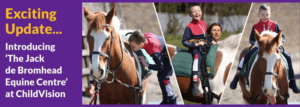
Home > Who we are > Our History
The old permeates the new in ChildVision, old values of service and commitment and of dedication inform and underpin every new encounter, whether with a blind child we’ve never met before or with a parent coming to realise the challenges multiple disability inevitable brings.
It’s about a simple ethic of helping make things better. That’s the ethic that explains best what ChildVision is fundamentally about. But this ethic of service doesn’t start with ChildVision. It’s an inherited characteristic, its roots deep in the soil of a place that first opened its doors to visually impaired people over more than a hundred and fifty years ago, is situated in Dublin 9, on the heritage site of Drumcondra Castle.
Naming it after St. Joseph, the Carmelite Brothers opened what is now ChildVision as a centre for blind men in 1870. These brothers were not the usual gathering of pious religious that then could be found all over Dublin, at the time the second city of the British Empire but famous, above all, for the grinding, slum bound poverty in which so many of its citizens lived.
Originally each of the brothers who named their new centre after St. Joseph, himself a craftsman, had been involved in a trade, doing jobs like wheelwright or barrel making or blacksmithing. Looking around at the despair of so many of their fellow Dubliners the Brothers knew that they wanted to alleviate their suffering. Eventually the Brothers identified the plight of the blind as being especially pitiful, with so many blind men, in particular, reduced to public begging just to stay alive.
Practical people that they were, the Brothers believed that rather than just providing a home to these men their human dignity demanded so much more. So, in defiance of a public wisdom that said blind men could never work for themselves, the Brothers set up workshops where the men learned to be basked weavers and mat makers. These workshops – however dated now – were, at the time, probable the first of their type in Europe and they helped create an early opportunity for blind people in Ireland to begin to escape the stigma of being regarded as unproductive and utterly dependent, of being seen only as objects of charity rather than as people who could actively shape their own lives.
This focus on practical service – of helping people take charge of their own lives – continued into the 1950s when responsibility for St. Joseph’s passed to another religious order, the Institute of Charity, better known as the Rosminians. By now St. Josephs, also known as ‘The Blind’, was also a school, offering primary and secondary education to blind and visually impaired boys from all over Ireland. But the total focus on being there to meet the practical, if ever-changing needs of Ireland’s young visually impaired population remained dynamic. The workshops had long since had their day but other opportunities to enrich the lives of St. Joseph’s young people were always being created. The concern, then as now, became about ensuring young people experienced happy, fulfilled lives and there began a huge and enduring emphasis being placed on training and preparing people to live as independently as possible.
Orientation and mobility training, independent living courses and practical opportunities to practice and enlarge these vital skills took on a central place in the young people’s daily schedules as did classes in music, arts and crafts and pottery. Sports moved into the mainstream, with games as diverse as soccer, table tennis and hockey adapted to enable the participation of people with sight loss. The next great change came in the 1980s when St. Josephs / ChildVision became among the very first centres in Ireland working with disabled people to close down its campus based, behind-the-walls, residential facilities in favour of an innovative move into the local community. So, young people who had previously lived in anonymous dormitories now moved into small houses, with all the opportunities this presented for living richer, more self-reliant and more visible lives. At the same time now courses in vocational education were added so that young people for whom traditional models of education were insufficient had meaningful access to lifelong learning opportunities.
So, by the early 1990’s ChildVision was now a fully integrated residential services open to young people from all over Ireland (and, occasionally, abroad), male and female, including young people with multiple and complex disabilities.
Throughout this rich, multi-layered history the guiding principle has been this constant and constantly renewed ethic of service. ChildVision is here for our young people. However and whatever their individual needs, our responsibility for almost one hundred and sixty years of unbroken service, remains about putting those needs first, re-inventing, re-invigorating and innovating to ensure that what we do today remains as vital to our young people and their families as it has at any time in our distinguished history of service. ChildVision is here for our young people.
Author credit James Forbes